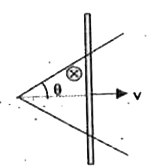Two straight conducting rails form a right angle where their ands are joined. A conducting bar contanct with the rails starts at vertex at the time t=0 & moves symmetrically with a constant velocity of 5.2m/s to the right as shown in figure. A 0.35T magnetic field point out of the page. Calculate:
(i) The flux through the tringle by the rails & ber at t=3.0s.
(ii) The emf around the tringle at that time.

In what manner does the emf around the tringle vary with time.
The correct Answer is:(i)85.22Tm2;(ii)56.8V;(iii)l∈early
(i)ϕ=BA,=B(12vt×vt)×2=Bv2t2
ϕ=0.35×(5.2)2×(3)2=85.22weber
(ii) e=∣dϕdt)=Bv22t=2Btv2<br>2×0.35×3×(5.2)2=56.8volt
(iii) e=2Bv2t⇒e∝t

Similar Questions
Two straight conducting rails from a right angle where their end are joined. A conducting bar polaced over the rails starts at vertex at the time t=0 and moves with a constant velocity v to the right as shown in the figure. Calculate (a) the flux through the triangle (isosceles) by the rails and bar at t=t_(0) the emf around the triangle at that time (c) in what manner does the emf around the triangle vary with time
View SolutionA conducting bar of mass m and length l moves on two frictionless parallel rails in the presence of a constant uniform magnetic field of magnitude B directed into the page as shown in the figure . The bar is given an initial velocity v_(0) towards the right at t = 0. Then the
View SolutionThe two conducting rails are placed perpendicular to each other, such that their ends are joined as shown in figure. A conducting bar is now placed over the rails and start moving with constant velocity v starting from the vertex at time t = 0. (i) The flux through the triangle (isosceles) by the rails and bar at t=t_(0) . (ii) The emf around the triangle at that time. (iii) In what manner does the emf around the triangle vary with time.
View SolutionA conducting bar of sufficient length is pulled with a constant velocity in a conducting shaped rail as shown in the figure . Inward magnetic field of induction B is present inside the area bounded by the bar & the rail. Find the external power delivered in moving the rail with constant velocity v at time t ( A= area of cross section of the bar ρ= resistivity of the bar )

View SolutionFigure shows a conducting rod of negligible resistance that can slide on smooth U-shaped rail made of wire of resistance 1Omega//m . Position of the conducting rod at t=0 is shown. A time dependent magnetic field B=2t tesla is switched on at t=0 The current in the loop at t=0 due to induced emf is
View SolutionFigure shows a conducting rod of negligible resistance that can slide on smooth U-shaped rail made of wire of resistance 1Omega//m . Position of the conducting rod at t=0 is shown. A time dependent magnetic field B=2t tesla is switched on at t=0 At t=0 , when the magnetic field is switched on, the conducting rod is moved to the left at constant speed 5cm//s by some external means. At t=2s , net induced emf has magnitude
View SolutionTwo straight conducting rails form a right angle where their ends are joined. A conducting bar in contact with the rails starts at the vertex at time t = 0 and moves with constant velocity v along them as shown in Fig. A magnetic field →B is directed into the page. the induced emf in the circuit at any time t is proportional to

View SolutionA conducting rod of length is moved at constant velocity v0 on two parallel, conducting, smooth, fixed rails, that are placed in a uniform constant magnetic field B perpendicular to the plane for the rails as shown in Fig. A resistance R is connected between the two ends of the rails.
Then which of the following is/are correct:

View Solution
